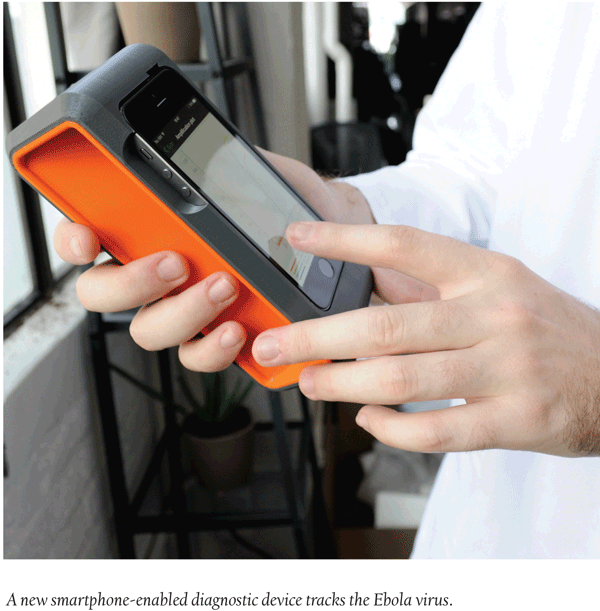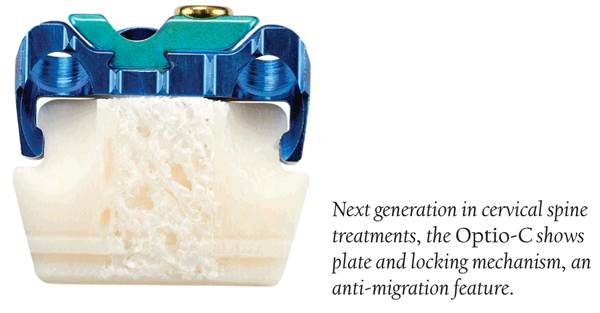TeleMed Texts: Tracking Ebola with Pocket Technology
Following the Texas Biomedical Research Institute’s pilot study of Biomeme’s new smartphone-enabled Ebola diagnostic device, which was found to have the ability to identify the virus in animals, the new technology is now being used to keep track of the spread of the deadly disease in West Africa.
What makes the device especially unique, according to the company, is that it is a low-cost, real-time PCR thermocycler that attaches to the iPhone 5s, essentially creating a “mobile” laboratory. According to the company, this technology provides the capability to perform accurate, gold-standard DNA analysis outside of the traditional lab environment. Test results are delivered quickly—within an hour—and the device has the capability to share results instantly with a Wi-Fi connection.
While the diagnostic device is currently being used to track the virus, it could also be used in the future in Ebola clinics.
Therapeutic Talk: Breast Cancer Screening: One Size Does Not Fit All
In the fight against breast cancer, early detection is critical. According to the National Breast Cancer Foundation, if detected early enough, patients have a 98% survival rate. This can be accomplished by employing newer technologies in the screening process.
While the traditional mammography has been the method of breast cancer detection since the 1960s, cancer is not a one size fits all disease, and likewise, the foundation notes, the screening process should not be either.
Today, emerging technologies such as breast tomosynthesis (3D mammography), ultrasound, breast magnetic resonance imaging (MRI), positron emission mammography (PEM), and molecular breast imaging (MBI) are all more comprehensive ways that may be implemented when screening for breast cancer.
The improved technologies could assist in making more accurate diagnoses, which leads to better suited treatment plans, but most importantly, they can assist in early detection. These wide-ranging screening methods are especially helpful for detection in those who are at high risk for the disease.
Trend Setting: AstraZeneca and Isis Collaborate on New Treatments
AstraZeneca and Isis Pharmaceuticals are currently expanding on their collaboration efforts to discover and codevelop innovative delivery methods for antisense oligonucleotides. The companies plan to enhance the path of antisense oligonucleotides to help them reach targeted organs and cells more effectively, a method that will build upon Isis Pharmaceutical’s successful Ligand Conjugation Antisense (LICA) technology.
Antisense oligonucleotides are short, single strands of DNA or RNA molecules that act before proteins are produced at messenger level RNA in a cell, and this leaves time for innovative therapeutic intervention. Isis is a leader in the antisense field, and together with AstraZeneca, the companies perform research and development in the field of antisense oligonucleotide-based therapeutics and RNA biology.
The project treatment scopes are focused primarily on oncology, cardiology and medical diseases.
Discoveries/Innovations: Cervical Spine Treatment Gets an Update
A no-profile treatment solution for patients who suffer with cervical degenerative disc disease in vertebrae C2-T1, Zimmer Spine’s newest FDA-approved device, the Optio-C Anterior Cervical System—a stand alone modular cervical device—represents the next generation in cervical spine treatments, and it promises to be a boon to patients as well as surgeons and physicians.
The cervical system is unique, according to the company, because it provides patients with a minimally invasive alternative to the traditional, more invasive Anterior Cervical Discectomy and Fusion (ACDF). The Optio-C system offers patients the strength, stability and fusion of the traditional ACDF, but without the typical soft tissue irritation. This technology also eliminates the need for additional plating when dealing with adjacent level disease.
For surgeons, the company says, the device offers many advantages including the peace of mind afforded by a high level of confidence in the locking mechanism, which contains an anti-migration feature.
Medical Device: First Hybrid Anchor Developed for Hip/Shoulder Repair
The DePuy Synthes Companies of Johnson and Johnson, developed the first arthroscopic hybrid anchor solution, Gryphon Anchors with ProKnot Technology, to repair shoulder and hip instability. The Gryphon ProKnot Anchor is primarily indicated for patients that suffer from Bankart lesions, an injury resulting from shoulder dislocation, and SLAP lesions, resulting from injury of the glenoid labrum, capsular shift or capsulolabral shoulder reconstruction and hip capsular and acetabular labral repairs.
Like traditional anchors, the Gryphon ProKnot Anchor offers the same control and consistency, but with a low profile repair and the efficient use of knotless anchors. The proprietary, pre-tied knot is 64% smaller than traditional arthroscopic knots, and 41% stronger than traditional arthroscopic knots and knotless devices.
In a report, Ian Lawson, Worldwide President of Mitek Sports Medicine said, “Surgeons no longer have to choose between traditional or knotless anchors for instability repair. We believe Gryphon ProKnot is an important innovation and can make a real difference for surgeons and patients.”
FDA Update
Inspection of Generic Evaluation
The FDA will undergo full inspections by OIG to evaluate their standards on generic drug regulations. The focus will be on clinical trials and inspections of generic drug manufacturers, areas that may be in need of some changes.
Drug Approval
Eli Lilly received FDA approval for Cyramza (ramucirumab), a treatment to be used in conjunction with paclitaxel chemotherapy, for patients with advanced or metastatic gastric cancer. This therapy is for those who have not responded well to prior forms of chemotherapy.
Janssen also received FDA approval for Olysio, a combination therapy with sofosbuvir, an all-oral interferon and ribavirin-free drug treatment used to treat adult patients with genotype 1 chronic hepatitis C (CHC).
Preliminary Feedback
Avanir received preliminary feedback by the FDA on their NDA for AVP-825, a breath-powered drug device that will be used for the treatment of acute migraines. The agency is requesting that the company conduct a new human factors validation study before it can be approved.
Device Approval
The FDA has approved ImThera’s investigational device exemption (IDE) for their THN3 clinical study, a study that will monitor the safety and efficacy of the aura6000, a system that is used for patients with moderate to severe obstructive sleep apnea.
Breakthrough Therapy Designation
Spark Therapeutics received a breakthrough therapy designation for SPK-RPE65, a treatment for nyctalopia or night blindness, in patients with Leber’s congenital amaurosis as a result of RPE65 gene mutations. The designations are sustained by two earlier successful trails.







